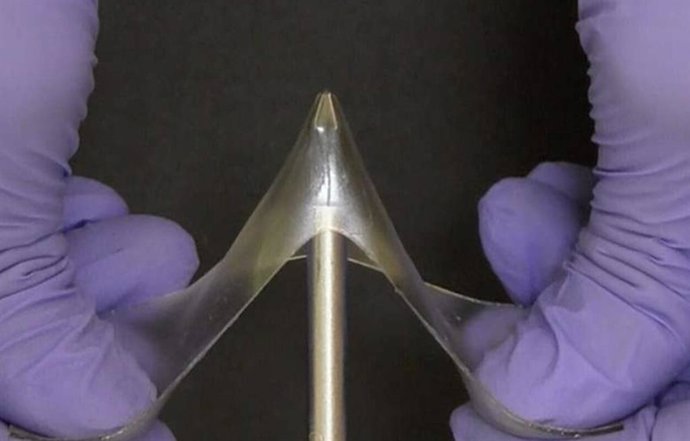Researchers have created a new class of materials called “glassy gels” that are as hard as glassy polymers, but, if enough force is applied, they can stretch up to five times their original length, rather than breaking. – MEIXIANG WANG, NC STATE UNIVERSITY
June 19 () –
In the North Carolina State University have created a new class of materials called ‘vitreous gels’ which are very hard and difficult to break despite containing more than 50% liquid.
Added to the fact that vitreous gels are easy to produce, the material – which is presented in an article in the ‘Nature’ magazine -is promising for a variety of applications.
Gels and glassy polymers are classes of materials that have historically been considered distinct from each other. Vitreous polymers are hard, rigid and often brittle. They are used to make things like water bottles or airplane windows. Gels, like contact lenses, contain liquid and are soft and elastic.
“We have created a class of materials that we call glassy gels, which are as hard as glassy polymers, but, if enough force is applied, they can stretch up to five times their original length, rather than breaking,” says Michael Dickey, professor of Chemical and Biomolecular Engineering. “What’s more, once the material is stretched, it can be returned to its original shape by applying heat. “In addition, the surface of vitreous gels is very adhesive, which is unusual for hard materials.”
“A key thing that distinguishes vitreous gels is that they are more than 50% liquid, making them more efficient conductors of electricity than common plastics that have comparable physical characteristics,” says Meixiang Wang, co-senior author of the paper and researcher. postdoctoral.
“Considering the number of unique properties they possess, We are optimistic that these materials will be useful“Wang says.
Vitreous gels, as their name suggests, are indeed a material that combines some of the most attractive properties of both polymers and vitreous gels. To make them, researchers start with liquid precursors of glassy polymers and mix them with an ionic liquid. This combined liquid is poured into a mold and exposed to ultraviolet light, which “cures” the material. The mold is then removed, leaving the vitreous gel behind.
“The ionic liquid is a solvent, like water, but it is composed entirely of ions,” Dickey says. “Normally, when a solvent is added to a polymer, the solvent separates the polymer chains, making the polymer soft and stretchable. This is why a wet contact lens is flexible and a dry contact lens is not. In glassy gels, the solvent separates the molecular chains of the polymer, allowing it to stretch like a gel. However, the ions in the solvent are strongly attracted to the polymer, preventing the polymer chains from moving. of the chains to move is what makes it glassy. The end result is that the material is hard due to the attractive forces, but is still able to stretch due to the extra space“.
The researchers discovered that vitreous gels can be made from a variety of different polymers and ionic liquids, although not all kinds of polymers can be used to create glassy gels.
“Charged or polar polymers are promising for glassy gels, because they are attracted to the ionic liquid,” Dickey says.
In tests, researchers found that vitreous gels do not evaporate or dry, even though they are 50 to 60 percent liquid.
“Perhaps the most intriguing feature of vitreous gels is how adhesive they are,” Dickey says. “Because while we understand what makes them hard and elastic, we can only speculate about what makes them so sticky.”
Researchers also believe that vitreous gels hold promise for practical applications because they are easy to manufacture.
“Creating vitreous gels is a simple process that can be carried out by curing it in any type of mold or printing it in 3D” says Dickey. “Most plastics with similar mechanical properties require manufacturers to create a polymer as a raw material and then transport it to another facility where the polymer is melted and converted into the final product.
“We are excited to see how glassy gels can be used and are open to working with collaborators to identify applications for these materials.”













Add Comment